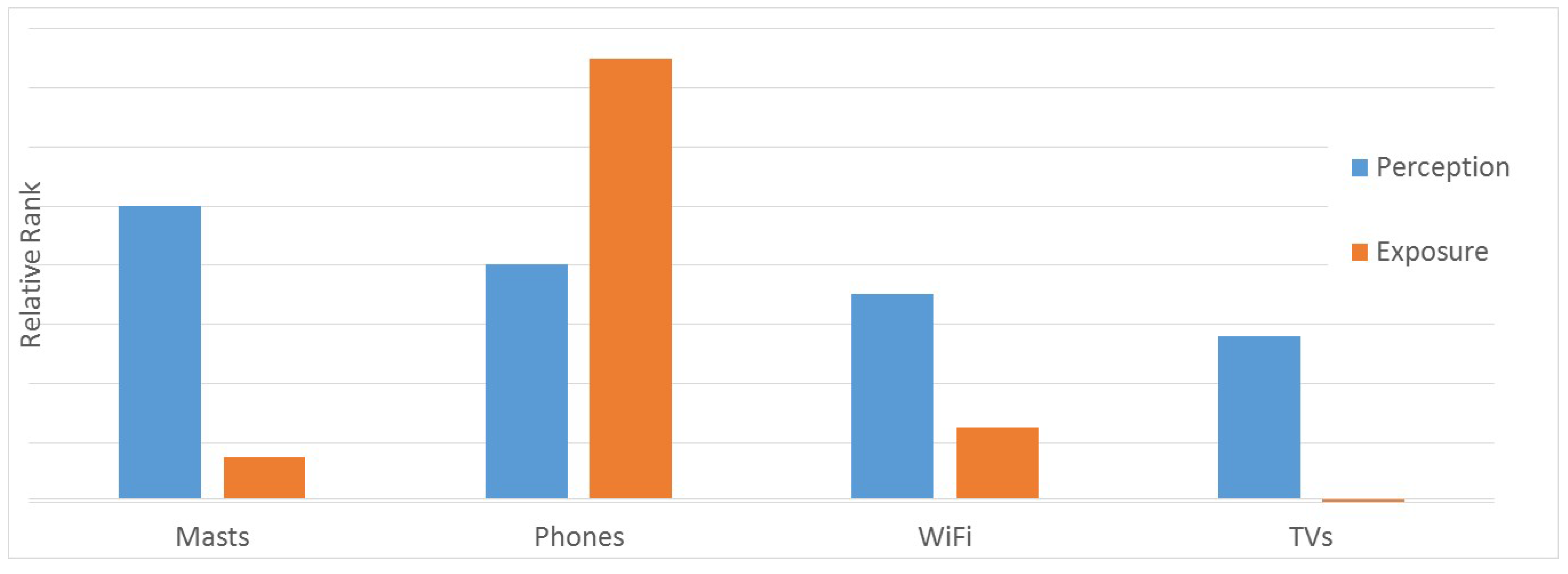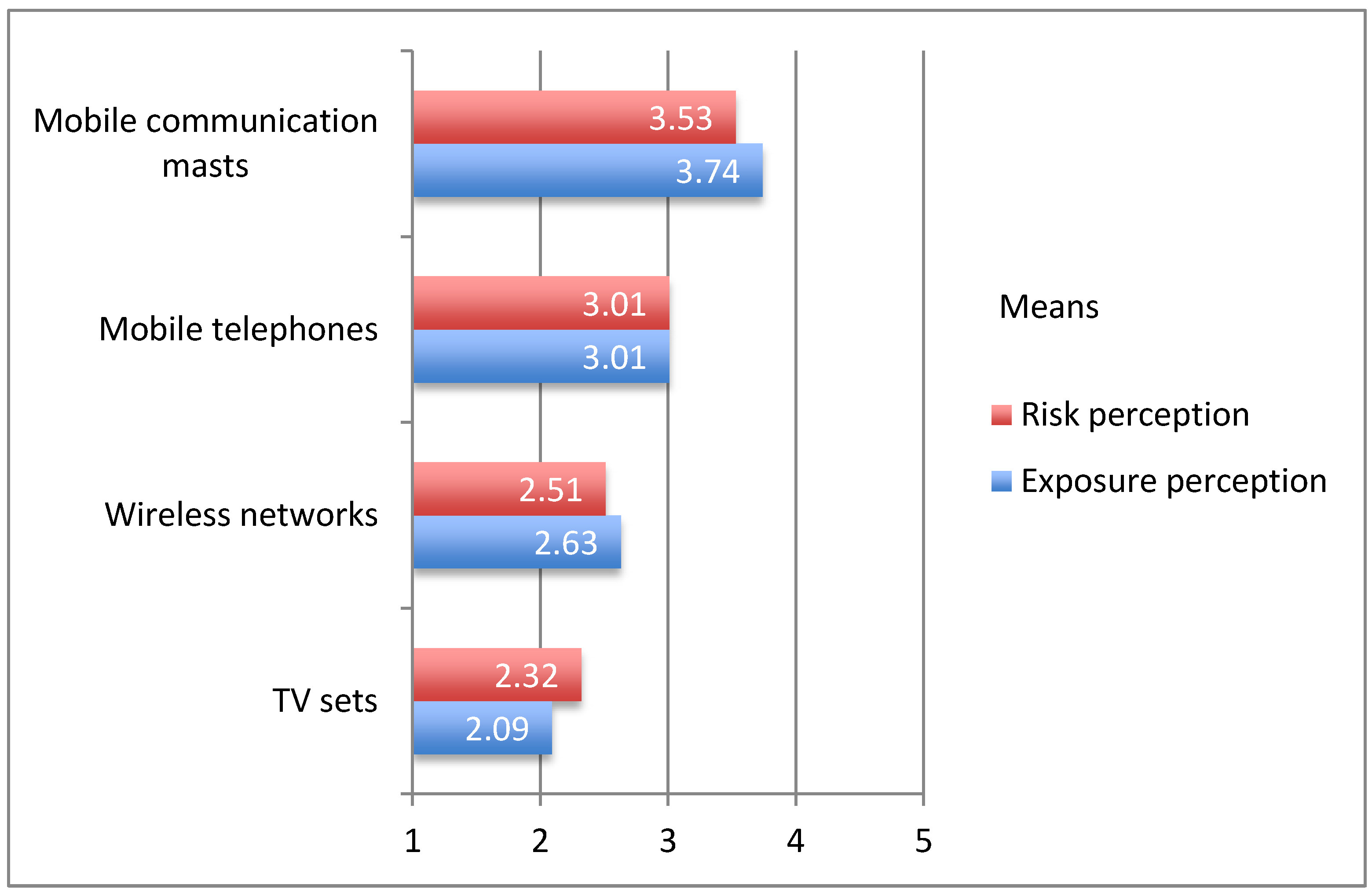Exposure Knowledge and Perception of Wireless Communication Technologies
Abstract
:1. Introduction
2. Background and Research Questions
- How accurate is the intuitive exposure perception?
- How are people’s risk perceptions related to their intuitive exposure perceptions?
- How accurate is intuitive knowledge about the influence of RF EMF exposure characteristics on health risks?
- Does intuitive knowledge about the influence of RF EMF exposure characteristics on health risks influence people’s RF EMF risk perception?
3. Sample and Methods
3.1. Sample
3.2. Method
4. Results
4.1. Real RF EMF Exposure and Exposure Perception
| Device System | User Exposure (Electric Field) [V/m] |
|---|---|
| Mobile phone | <10 |
| Wireless networks at home | <1 |
| Mobile communication masts | <0.3 |
| TV set | 0 |
| Exposure Source | Mean Exposure Perception | Real User Exposure [V/m] | Tendency Over-/Underestimate |
|---|---|---|---|
| Mobile communication masts | 3.74 | <0.3 | ↑ |
| Mobile telephones | 3.01 | <10 | ↓ |
| Wireless networks at home | 2.63 | <1 | ↑ |
| TV set | 2.09 | 0 | ↑ |

4.2. Exposure Perception and Risk Perception

4.3. Subjective Exposure Impact Knowledge and Risk Perception

| Regression Exposure Characteristics, Base Station | β-Value | p |
|---|---|---|
| Duration | 0.026 | 0.680 |
| Distance | −0.008 | 0.874 |
| Frequency | 0.105 | 0.025 * |
| Strength | −0.060 | 0.221 |
| Number of sources | 0.083 | 0.056 |
| Time of day | 0.089 | 0.016 * |
| Size | 0.185 | 0.000 * |
| Regression Exposure Characteristics, Mobile Phones | β-Value | p |
|---|---|---|
| Duration | 0.112 | 0.027 * |
| Distance | 0.013 | 0.794 |
| Frequency | 0.114 | 0.016 * |
| Strength | −0.035 | 0.474 |
| Number of sources | 0.088 | 0.045 * |
| Time of day | 0.114 | 0.002 * |
| Size | 0.085 | 0.030 * |
| WLAN Router | TV Sets | ||||
|---|---|---|---|---|---|
| Regression Exposure Characteristics, WLAN | β-Value | p | Regression Exposure Characteristics, TV Set | β-Value | p |
| Duration | 0.052 | 0.307 | Duration | 0.048 | 0.350 |
| Distance | −0.049 | 0.324 | Distance | −0.073 | 0.150 |
| Frequency | 0.065 | 0.171 | Frequency | 0.028 | 0.565 |
| Strength | −0.040 | 0.411 | Strength | −0.005 | 0.932 |
| Number of sources | 0.165 | 0.000 * | Number of sources | 0.094 | 0.036 * |
| Time of day | 0.167 | 0.000 * | Time of day | 0.190 | 0.000 * |
| Size | 0.052 | 0.186 | Size | 0.062 | 0.115 |
4.4. Quality of Subjective Exposure Impact Knowledge and Risk Perception
| Source of Exposure | Mean Group Adequate Knowledge | Mean Group Inadequate Knowledge | F | p | η2 |
|---|---|---|---|---|---|
| TV set | 2.12 | 2.38 | 1.09 | 0.297 | 0.0159 |
| Mobile telephones | 2.89 | 2.80 | 0.11 | 0.737 | 0.0016 |
| Mobile communication masts | 3.19 | 3.43 | 0.68 | 0.410 | 0.0100 |
| Wireless network at home | 2.49 | 2.36 | 0.26 | 0.608 | 0.0038 |
5. Strength and Limitations of the Study
6. Discussion
7. Conclusions
Acknowledgments
Author Contributions
Conflicts of Interest
References
- ITU. ICT Facts and Figures 2015. Available online: http://www.itu.int/en/ITU-D/Statistics/Pages/default.aspx (accessed on 30 October 2015).
- WHO. Electromagnetic Fields and Public Health: Mobile Phones. 2014. Available online: http://www.who.int/mediacentre/factsheets/fs193/en/ (accessed on 30 October 2015).
- IARC. IARC Classifies Radiofrequency Electromagnetic Fields As Possibility Carcinogenic to Humans. 2011. Available online: http://www.iarc.fr/en/media-centre/pr/2011/pdfs/pr208_E.pdf (accessed on 30 October 2015).
- SCENIHR. Opinion on Potential Health Effects of Exposure to Electromagnetic Fields (EMF). 2015. Available online: http://ec.europa.eu/health/scientific_committees/emerging/docs/scenihr_o_041.pdf (accessed on 30 October 2015).
- IARC. IARC Monographs on the Evaluation of Carcinogenic Risks to Humans Coffee, Tea, Mate, Methylxanthines and Methylglyoxa; IARC: Lyon, France, 1991. [Google Scholar]
- IARC. IARC Monographs. 2015. Available online: http://monographs.iarc.fr/ENG/Classification (accessed on 30 October 2015).
- Wiedemann, P.M.; Schuetz, H.; Boerner, F.; Clauberg, M.; Croft, R.; Shukla, R.; Kikkawa, T.; Kemp, R.; Gutteling, J.M.; de Villiers, B.; et al. When Precaution Creates Misunderstandings: The Unintended Effects of Precautionary Information on Perceived Risks, the EMF Case. Risk Anal. 2013, 33, 1788–1801. [Google Scholar] [CrossRef] [PubMed]
- Barnett, J.; Timotijevic, L.; Shepherd, R.; Senior, V. Public responses to precautionary information from the Department of Health (UK) about possible health risks from mobile phones. Health Policy 2007, 82, 240–250. [Google Scholar] [CrossRef] [PubMed]
- LEXNET. Low EMF Exposure Future Networks. 2015. Available online http://www.lexnet-project.eu. (accessed on 30 October 2015).
- Tesanovic, M.; Conil, E.; De Domenico, A.; Agüero, R.; Freudenstein, F.; Correia, L.M.; Bories, S.; Martens, L.; Wiedemann, P.M.; Wiart, J. Wireless networks and EMF—Paving the way for low-EMF networks of the future: The LEXNET project. IEEE Vehic. Technol. Mag. 2014, 9, 20–28. [Google Scholar] [CrossRef]
- Eurobarometer TNS Opinion and Social. Electromagnetic Fields. 2010. Available online: http://ec.europa.eu/public_opinion/archives/ebs/ebs_347_en.pdf (accessed on 30 October 2015).
- Baliatsas, C.; Bolte, J.; Yzermans, J.; Kelfkens, G.; Hooiveld, M.; Lebret, E.; van Kamp, I. Actual and perceived exposure to electromagnetic fields and non-specific physical symptoms: An epidemiological study based on self-reported data and electronic medical records. Int. J. Hyg. Environ. Health. 2015, 218, 331–344. [Google Scholar] [CrossRef] [PubMed]
- MacGregor, D.G.; Slovic, P.; Malmfors, T. “How exposed is exposed enough?” Lay inferences about chemical exposure. Risk Anal. 1999, 19, 649–659. [Google Scholar] [CrossRef] [PubMed]
- Freudenstein, F.; Wiedemann, P.M.; Brown, T.W.C. Exposure perception as a key indicator of risk perception and acceptance of sources of radio frequency electromagnetic fields. J. Environ. Publ. Health 2015, 2015. [Google Scholar] [CrossRef] [PubMed]
- Cousin, M.E.; Siegrist, M. Risk perception of mobile communication: A mental models approach. J. Risk Res. 2010, 13, 599–620. [Google Scholar] [CrossRef]
- Freudenstein, F.; Wiedemann, P.M.; Pejanović-Djurišić, M.; Koprivica, M.; Nešković, A. Intuitive exposure and risk perception of RF EMF: Case studies Serbia and Montenegro. In Telecommunications Forum Telfor (TELFOR); IEEE: New York, NY, USA, 2014. [Google Scholar]
- Freudenstein, F.; Wiedemann, P.M.; Varsier, N. Exposure knowledge and risk perception of RF EMF. Front. Publ. Health 2015, 2. [Google Scholar] [CrossRef] [PubMed]
- Bornkessel, C.; Wuschek, M. Bestimmung der Realen Feldverteilung von Hochfrequenten Elektromagnetischen Feldern in der Umgebung von UMTS-Sendeanlagen. Available online: http://www.bmub.bund.de/fileadmin/bmuimport/files/pdfs/allgemein/application/pdf/schriftenreihe_rs703.pdf (accessed on 30 October 2015).
- Interphone Study Group. Brain tumour risk in relation to mobile telephone use: Results of the Interphone international case-control study. Int. J. Epidemiol. 2010, 39, 675–694. [Google Scholar] [CrossRef] [PubMed]
- SSK. Vergleichende Bewertung der Evidenz von Krebsrisiken Durch Elektromagnetische Felder und Strahlungen. Available online: http://www.ssk.de/SharedDocs/Beratungsergebnisse_PDF/2011/2011_06.pdf?__blob=publicationFile (accessed on 30 October 2015).
- CORDIS. D2.5 Risk and Exposure Perception I and II. Available online: http://cordis.europa.eu/docs/projects/cnect/3/318273/080/deliverables/001LEXNETWP2D25RiskandexposureperceptionV2Ares20159686.pdf (accessed on on 28 September 2015).
- ESS. ESS Round 6 Source Questionnaire. 2012. Available online: http://www.europeansocialsurvey.org (accessed on 28 September 2015).
- Oliveira, C.; Sebastiao, D.; Ladeira, D.; Antunes, M.; Correia, L.M. Electromagnetic fields measurements in Portuguese Schools. In Proceedings of ICNIRP International Conference on Non-Ionizing Radiation and Children’s Health, Ljubljana, Slovenia, 18–20 May 2011.
- IT’IS Foundation. Development of Procedures for the Assessment of Human Exposure to EMF from Wireless Devices in Home and Office Environments. 2006. Available online: http://www.bag.admin.ch/themen/strahlung/00053/00921/00922/index.html?lang=en&download=NHzLpZeg7t,lnp6I0NTU042l2Z6ln1ad1IZn4Z2qZpnO2Yuq2Z6gpJCDdHx2gmym162epYbg2c_JjKbNoKSn6A (accessed on 30 October 2015).
- ICNIRP. ICNIRP guidelines for limiting exposure to time-varying electric, magnetic and electromagnetic fields (up to 300 GHz). Health Phys. 1998, 74, 494–522. [Google Scholar] [PubMed]
- Slovic, P. Perception of risk: Reflections on the psychometric paradigm. In Social Theories of Risk; Krimsky, S., Golding, D., Eds.; Praeger: Westport, CT, USA, 1992. [Google Scholar]
- Gregory, R.; Mendelsohn, R. Perceived Risk, Dread, and Benefits. Risk Anal. 1993, 13, 259–264. [Google Scholar] [CrossRef]
- Slovic, P.; Peter, E. Risk perception and affect. Curr. Dir. Psychol. Sci. 2006, 15, 322–325. [Google Scholar] [CrossRef]
© 2015 by the authors; licensee MDPI, Basel, Switzerland. This article is an open access article distributed under the terms and conditions of the Creative Commons Attribution license (http://creativecommons.org/licenses/by/4.0/).
Share and Cite
Freudenstein, F.; Correia, L.M.; Oliveira, C.; Sebastião, D.; Wiedemann, P.M. Exposure Knowledge and Perception of Wireless Communication Technologies. Int. J. Environ. Res. Public Health 2015, 12, 14177-14191. https://doi.org/10.3390/ijerph121114177
Freudenstein F, Correia LM, Oliveira C, Sebastião D, Wiedemann PM. Exposure Knowledge and Perception of Wireless Communication Technologies. International Journal of Environmental Research and Public Health. 2015; 12(11):14177-14191. https://doi.org/10.3390/ijerph121114177
Chicago/Turabian StyleFreudenstein, Frederik, Luis M. Correia, Carla Oliveira, Daniel Sebastião, and Peter M. Wiedemann. 2015. "Exposure Knowledge and Perception of Wireless Communication Technologies" International Journal of Environmental Research and Public Health 12, no. 11: 14177-14191. https://doi.org/10.3390/ijerph121114177
APA StyleFreudenstein, F., Correia, L. M., Oliveira, C., Sebastião, D., & Wiedemann, P. M. (2015). Exposure Knowledge and Perception of Wireless Communication Technologies. International Journal of Environmental Research and Public Health, 12(11), 14177-14191. https://doi.org/10.3390/ijerph121114177





